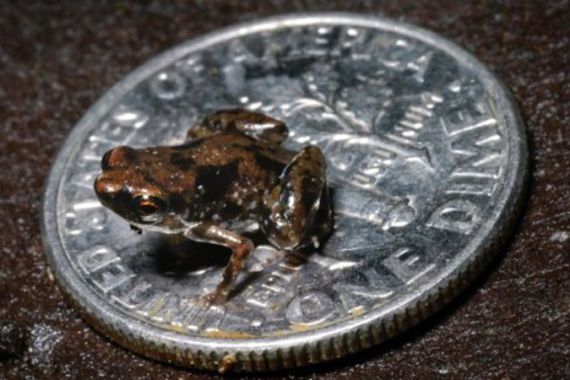Tiny frogs are world’s ‘smallest’ vertebrates
Discovered in the Papua New Guinea rainforest, they have barely beaten an Indonesian fish that got the title in 2006.

 |
| One of the frogs is only around 7 millimetres in size and has lived out of sight in Papua New Guinea for a long time [AFP] |
Frogs that can perch on the tip of your little finger with room to spare have been claimed as the world’s smallest vertebrates, out-tinying a fish that got the title in 2006.
The Paedophryne amauensis and Paedophryne swiftorum are now the smallest known frogs as well as the smallest known vertebrates, a report in the science journal PLoS ONE said on Wednesday.
Keep reading
list of 4 itemsAfter the Hurricane
World’s coral reefs face global bleaching crisis
Why is Germany maintaining economic ties with China?
The frogs, that live in Papua New Guinea’s rainforest, are about 7.7 millimetres and 8 millimetres long.
Until now the smallest vertebrate was believed to be a transparent Indonesian fish known as Paedocypris progenetica that averaged about eight millimetres.
The largest vertebrate is the blue whale, measuring about 25.8 metres.
“It was particularly difficult to locate Paedophryne amauensis due to its diminutive size and the males’ high pitched insect-like mating call,” said Chris Austin, a scientist at the Louisiana State University in the US, who discovered them.
Hypothesis contradicted
Austin said that since these frogs hatch out as hoppers rather than tadpoles and live on the ground, their existence contradicts the hypothesis that evolution at large and small extremes is linked to life in water.
The dark brown frogs with bluish-white specks have likely existed for a long time, underfoot and out of sight on the rainforest floor, eating smaller prey or being eaten by bigger predators.
“The ecosystems these extremely small frogs occupy are very similar, primarily inhabiting leaf litter on the floor of tropical rainforest environments,” said Austin.
“We now believe that these creatures aren’t just biological oddities, but instead represent a previously undocumented ecological guild – they occupy a habitat niche that no other vertebrate does.”
In fact, judging by the frequency of male mating calls they heard, Austin said the tiny frogs might be spaced as close as 50 centimetres from each other on ground beneath the leaves.
Maurice Kottelat, a Swiss scientist who found the tiny Indonesian fish, wrote in an email that it is hard to compare frogs and fish, because they are measured differently: frogs from nose-tip to the excretory vent, and fish from nose to tail.
“It is not so interesting to know which is really the smallest. Tomorrow will bring another smallest anyway,” he wrote.
“I have a great concern. It is not when will we discover the next smallest, but whether habitats where to discover them will still be there. Or how long will the habitats survive. Since the discovery of Paedocypris most of the fragile peat swamps that it inhabits have been destroyed.”